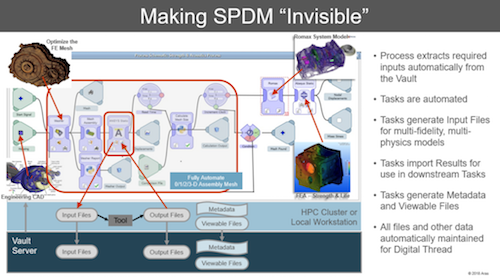Aras Goes All-In on Simulation Process and Data Management
Fresh off releasing a detailed strategy for Simulation Process and Data Management (SPDM), Aras announced its acquisition of Comet Solutions, which markets simulation process management software.

Aras’ vision for “invisible” SPDM: No worrying about where the CAD model comes from, which HPC clusters to run on, or where results get stored. Image Courtesy of Aras.
Latest News
October 1, 2018
There’s lot of talk about pushing simulation to the forefront of the design process and even more forward thinking about analysis becoming a regular routine for mainstream engineers. In reality, however, simulation is still a specialized process used sparingly at key intervals in the cycle.
Experts tout a variety of reasons to explain why simulation is still not fully democratized despite the desire to reduce physical testing and in light of growing complexity due to the rise of smart, connected products, model-based systems engineering (MBSE), and the digital twin. PLM vendor Aras’ take is that simulation management remains disconnected from mainstream engineering processes, impeding closed loop traceability and introducing errors because models frequently become out of sync with product design.
The silo simulation scenario is about to change, however, if Aras has its way. Fresh off releasing a detailed strategy for Simulation Process and Data Management (SPDM), the firm announced its acquisition of Comet Solutions, which markets simulation process management software. In response to on-going customer demand, Aras is pursuing an open, flexible strategy for SPDM, allowing organizations to manage simulation at scale, accommodate a diversity of toolsets and include spreadsheets and custom applications. The company’s vision is to make SPDM “invisible” to users as they manage simulation models along with associated geometry and performance parameters.
“We’re not in the business of creating solvers or meshers, this is a business engineering use case and it’s about process enablement in context and a full lifecycle digital thread,” explains Aras Senior Vice President, Strategy, Marc Lind. The idea of SPDM being “invisible” to users means they shouldn’t have to worry about where the CAD model comes from, which HPC cluster to run on, or where the results get stored—all core objectives for the future Aras SPDM solution based on the Comet technology.
Key to the Comet offering is a unified data model, which can handle mixed fidelity models and different data types. Comet’s approach is also different than other SPDM platforms in that it extracts intelligence from simulation models and results as opposed to managing data at the file level. Together, these capabilities help connect simulation to mainstream engineering processes so it is done in the context of the product’s configuration, variances, and correlation to testing.
“Today’s SPDM installations are mainly siloed, and most of the major providers handle their own tools in a deeply integrated way while treating all other solvers as second class citizens,” Lind says. “We wanted to handle it in a better, more consistent way.”
In addition to the unified data model, the Comet Solutions’ technology puts a heavy emphasis on process, including the ability to create tool chain automation—the linking of simulation tools to perform complex functions and analysis. With such an ability to streamline workflow, simulation users can ensure reuse of key processes for evaluating product variations and concept designs and for better managing job execution, including job server, data extract, pull files and operations on HPC clusters.
“A better tool chaining foundation leads to higher order processes and initiatives,” Lind says. “Without it, processes are not repeatable and it takes too much time to be able to increase simulation coverage on design and ultimately increase the volume of simulation necessary for the future we all anticipate.”
Comet Solutions’ software will be available to Aras subscribers at no charge as part of their Aras Innovator license.
Watch this Digital Engineering interview with Comet Solutions’ Malcolm Panthaki to hear more about his vision to advance analysis and simulation in engineering.
More Aras Coverage
Subscribe to our FREE magazine, FREE email newsletters or both!
Latest News
About the Author
Beth Stackpole is a contributing editor to Digital Engineering. Send e-mail about this article to [email protected].
Follow DE





